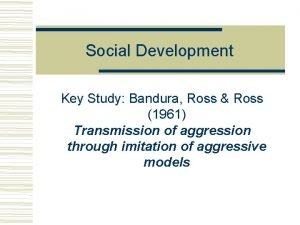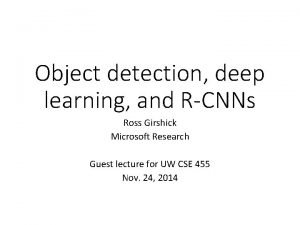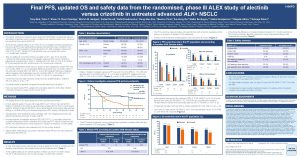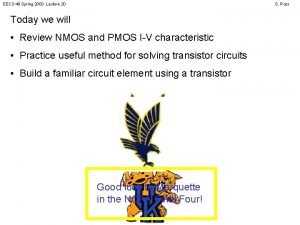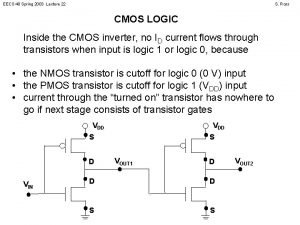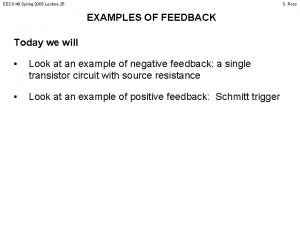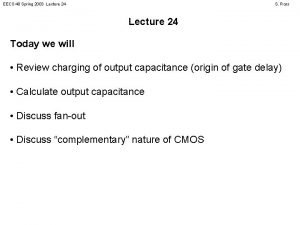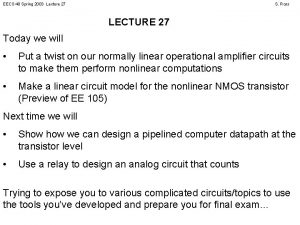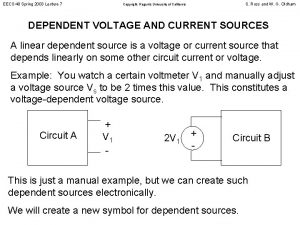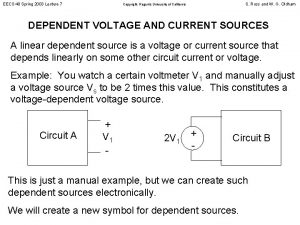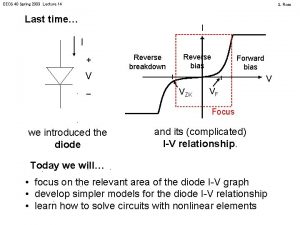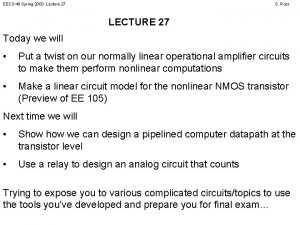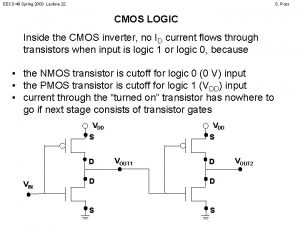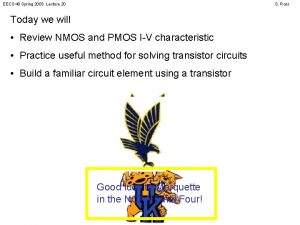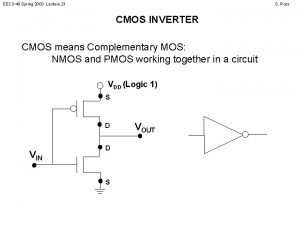EECS 40 Spring 2003 Lecture 16 S Ross
















- Slides: 16

EECS 40 Spring 2003 Lecture 16 S. Ross NMOS (N-Channel Metal Oxide Semiconductor) Transistor gate source metal n-type h e e e h drain metal oxide insulator h metal n-type h e e e p-type h metal h

EECS 40 Spring 2003 Lecture 16 S. Ross NMOS Transistor in Equilibrium gate source metal n-type + + + _ _ metal oxide insulator _ h h drain metal _ n-type + + + _ _ p-type h h metal When the transistor is left alone, some electrons from the n-type wells diffuse into the p-type material to fill holes. This creates negative ions in the p-type material and positive ions are left behind in the n-type material.

EECS 40 Spring 2003 Lecture 16 S. Ross NMOS Transistor in Cutoff VGS > 0 gate - + source metal n-type + + + _ _ h _ metal oxide insulator _ _ drain metal n-type + + + _ _ p-type h h metal When a small, positive VGS is applied, holes “move away” from the gate. Electrons from complete atoms elsewhere in the p-type material move to fill holes near the gate instead.

EECS 40 Spring 2003 Lecture 16 S. Ross NMOS Transistor Channel VGS > VTH(N) gate - + source metal n-type + + + _ _ h h h metal oxide insulator ee_ e _ _ drain metal n-type + + + _ _ p-type h h h h metal When VGS is larger than a threshold voltage VTH(N), the attraction to the gate is so great that free electrons collect there. Thus the applied VGS creates an induced n-type channel under the gate (an area with free electrons).

EECS 40 Spring 2003 Lecture 16 S. Ross NMOS Transistor Drain Current - + VGS > VTH(N) VDS > 0 gate - + source metal n-type + + + _ _ h h h metal oxide insulator ee_ e _ _ drain metal n-type + + + _ _ p-type h h h h metal When a positive VDS is applied, the free electrons flow from the source to the drain. (Positive current flows from drain to source). The amount of current depends on VDS, as well as the number of electrons in the channel, channel dimensions, and material.

EECS 40 Spring 2003 Lecture 16 S. Ross NMOS Transistor VDS - + VGS gate - + source ID IG drain metal oxide insulator metal n-type p-type metal G + _ S IG V ID GS - VDS + D

EECS 40 Spring 2003 Lecture 16 S. Ross NMOS I-V CHARACTERISTIC G + _ S IG V ID GS - VDS + D • Since the transistor is a 3 -terminal device, there is no single I-V characteristic. • Note that because of the insulator, IG = 0 A. • We typically define the MOS I-V characteristic as ID vs. VDS for a fixed VGS.

EECS 40 Spring 2003 Lecture 16 S. Ross MODES OF OPERATION For small values of VGS, VGS ≤ VTH(N), the n-type channel is not formed. No current flows. This is cutoff mode. When VGS > VTH(N), current ID may flow from drain to source, and the following modes of current flow are possible. The mode of current flow depends on the propelling voltage, VDS, and the channel-inducing voltage, VGS – VTH(N). When VDS < VGS – VTH(N), current is starting to flow. ID increases rapidly with increased VDS. This is triode mode. When VDS ≥ VGS – VTH(N), current is reaching its maximum value. ID does not increase much with increased VDS. This is called saturation mode.

EECS 40 Spring 2003 Lecture 16 S. Ross NMOS I-V CHARACTERISTIC Cutoff Mode • Occurs when VGS ≤ VTH(N) ID = 0 Triode Mode • Occurs when VGS > VTH(N) and VDS < VGS - VTH(N) Saturation Mode • Occurs when VGS > VTH(N) and VDS ≥ VGS - VTH(N)

EECS 40 Spring 2003 Lecture 16 S. Ross NMOS I-V CHARACTERISTICS ID triode mode saturation mode VGS = 3 V VDS = VGS - VTH(N) VGS = 2 V VGS = 1 V VDS cutoff mode

EECS 40 Spring 2003 Lecture 16 S. Ross PMOS (P-Channel Metal Oxide Semiconductor) Transistor gate source metal p-type metal oxide insulator drain metal p-type n-type metal Same as NMOS, only p-type and n-type switched

EECS 40 Spring 2003 Lecture 16 S. Ross PMOS Transistor Channel VGS < VTH(P) < 0 gate - + source metal p-type _ _ _ metal oxide insulator h +h+h + h + + e e e metal p-type _ _ _ + + + n-type e drain e e metal When VGS is more negative than a threshold voltage VTH(P), the gate attracts many positive ions and holes (repels electrons) Thus the applied VGS creates an induced p-type channel under the gate (an area with positive ions).

EECS 40 Spring 2003 Lecture 16 S. Ross PMOS Transistor Drain Current - + VGS < VTH(P) < 0 VDS < 0 gate - + source metal p-type _ _ _ metal oxide insulator h +h+h + h + + e e e metal p-type _ _ _ + + + n-type e drain e e metal When a negative VDS is applied, the positive ions flow from the source to the drain. (Positive current flows from source to drain). The amount of current depends on VDS, as well as the number of ions in the channel, channel dimensions, and material.

EECS 40 Spring 2003 Lecture 16 S. Ross PMOS TRANSISTOR G IG + _ S V ID GS - VDS + D Symbol has “dot” at gate. NMOS does not. ID, VGS, VDS, and VTH(P) are all negative. These values are positive for NMOS. Channel formed when VGS < VTH(P). Opposite for NMOS. Saturation occurs when VDS ≤ VGS – VTH(P). Opposite for NMOS.

EECS 40 Spring 2003 Lecture 16 S. Ross PMOS I-V CHARACTERISTIC Cutoff Mode • Occurs when VGS ≥ VTH(P) ID = 0 Triode Mode • Occurs when VGS < VTH(P) and VDS > VGS - VTH(P) Saturation Mode • Occurs when VGS < VTH(P) and VDS ≤ VGS - VTH(P)

EECS 40 Spring 2003 Lecture 16 S. Ross PMOS I-V CHARACTERISTICS VDS cutoff mode VGS = -1 V VGS = -2 V VDS = VGS - VTH(P) VGS = -3 V ID saturation mode triode mode
 Spring, summer, fall, winter... and spring cast
Spring, summer, fall, winter... and spring cast Aggressive role
Aggressive role 01:640:244 lecture notes - lecture 15: plat, idah, farad
01:640:244 lecture notes - lecture 15: plat, idah, farad Fall is what months
Fall is what months Nicole ross real
Nicole ross real Kübler ross haldoklás fázisai
Kübler ross haldoklás fázisai Sffas 50
Sffas 50 Karen ross and the value of speaking up
Karen ross and the value of speaking up Jim kurose lectures
Jim kurose lectures Ross girshick
Ross girshick Kemp model
Kemp model Ross camidge
Ross camidge Malcolm ross model
Malcolm ross model Harry s murphy ole miss
Harry s murphy ole miss Ross forgione
Ross forgione Valentin ross german chemist
Valentin ross german chemist Ross bagurdes
Ross bagurdes

